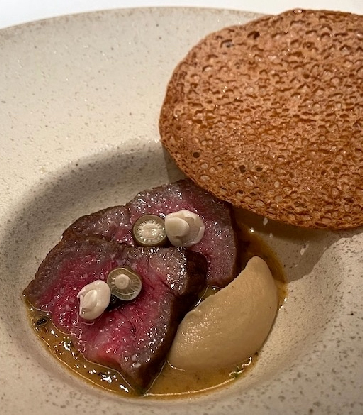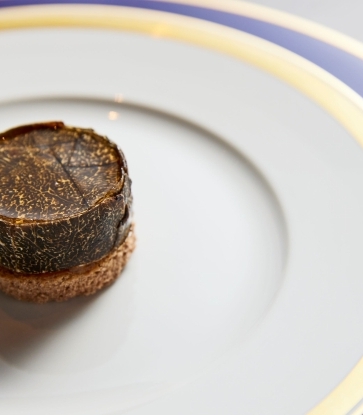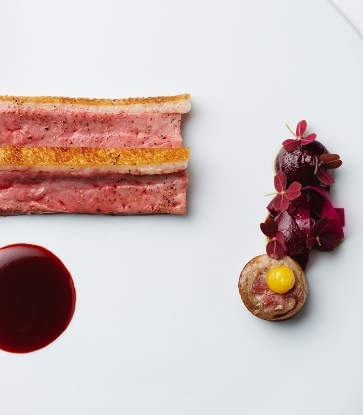Prik kee noo suan (Bird's eye chilli)
I first came across these hot and fiery chillies travelling through Thailand many years ago. I was in Bangkok visiting the Grand Palace and ate at the Wang Lang Market just across the Chao Phraya River. I’ll never forget my first taste of a tom yum soup enlivened with these chillies – it was flavour-packed, spicy, refreshing and sour all at the same time – and it blew me away. I was hooked and my love of Thai cuisine and these wonderful chillies had begun.
If there’s one ingredient that elevates a range of Thai dishes in so many ways then this small chilli would be it. Its versatility knows no bounds; whether that’s lifting a simple green papaya salad (som tam) or adding depth and structure to a red duck curry (kaeng phet pet yang). The fiery, deeply intense nam prik pao can also elevate a bowl of noodle soup to unforeseen heights with its delicious blend of spice and sweetness. Once you’re addicted there are endless dishes to explore which benefit from this terrific ingredient.
READ ALSO: A Foodie's Guide to Peruvian Chillies

Crab
Some stand in front of jeweller’s windows gazing admiringly at designer watches; I’m transfixed by a fishmonger’s and can stare for ages – but it’s not prawns, lobster or Dover sole that gets my heart racing – it’s crab.
I grew up close to the sea and can still remember seeing this wonderful, ugly beast sitting proudly on the kitchen board, ready for the pot. My father was a crab fiend and he introduced me to this blessed creature and started me on this journey to eat it in its many guises around the world; soft shell, mud, rock, snow, Dungeness, blue, spider, king, brown and both hen and cock varieties.
When I was 12 I got a part-time job in a fish shop and was one day assigned crab duties. The owner came in later to see a table filled with broken crab shells but his smile at the amount of work I’d done soon turned to a grimace when he saw the paltry amount of crab – I hadn’t been able to stop myself eating the wonderfully sweet meat. So that was the end of that job.
And how do I like them? Crab cakes are a joy (I can still taste the ones from a crab shack in Chesapeake Bay in Maryland many years ago) as is a warm, freshly boiled crab with some new potatoes and mayonnaise; but nothing really beats the holy trinity of ripe avocado, pink grapefruit and fresh white seasoned crabmeat.
READ ALSO: Tottori: Crab Lovers’ Paradise

Parsnips
The Romans considered them an aphrodisiac; the Chinese use them as medicine; and during the war they were a sugar substitute for making cakes or wine for the vicar…but my love came about as a child when I was encouraged to grow things in the garden that we could eat – and parsnips seemed to pop up through the ground rather well. I admit they are rather a Marmite thing – you either love them or hate them and for me their sweetness is what drew me to them as I have always possessed something of a sweet tooth.
Other root vegetables like celeriac always seem to have better PR agents and enjoy more fashionable reputations but the parsnip is such a versatile vegetable. It can be roasted, toasted, steamed, pureed, stir-fried or mashed; it can provide a solid backbone alongside healthy leaves and shoots in a juice; it brings comfort and silkiness to a soup (with Nip & Nip being a personal favourite); and who can resist a dish of crunchy parsnip crisps with an aperitif?
There’s nothing better to go with some roast venison and they’re a reassuring accompaniment to a casserole or pie. And no Christmas dinner could ever be considered complete without them!

Mackerel
My first memory of mackerel was as a child, fishing on the west coast of Scotland, smiles on our faces as the floor of our boat became covered with glittering, flapping fish. It’s still a family favourite – easy to cook and healthy – delicious cooked over coals and served simply with a warm potato salad.
It’s a versatile ingredient that can be cooked in many different ways: smoked, pickled, cured and of course grilled. Smoked mackerel pâté is hard to resist (Nathan Outlaw’s recipe is a good one) and I also use Tom Kerridge’s recipe of blow-torched mackerel with beetroot relish. It’s my favourite piece of nigiri whenever I’m eating in sushi restaurants around the world, its fattiness and flavour working perfectly with the vinegar-infused rice. The Scandinavians like to add the contrasting flavours of horseradish and elderflower or the acidity of rhubarb or gooseberry. Of course they pickle it too and serve it on rye bread as smørrebrød. Mackerel works brilliantly with both Indian and Asian flavours and spices. I’ve driven across Spain a few times on holiday and even then I always have a few jars of Ortiz with me in the Jeep, just waiting for some fresh bread.

Pork
Family roasts growing up – a huge joint, golden cracking, sweet apple sauce and veg picked that morning from grandad’s garden – were a real family treat. And today I do the same for my family, with all the trimmings and all the memories.
I really love the vast range of products when it comes to pork – from the iconic pork pie to sausages, gammon and bacon; and I’m a big fan of Spanish and Italian dried hams, cured meats and salamis, with their regional subtleties, flavours and differing production techniques. It’s great how we all now want to know the breed before we order, be it Gloucester Old Spot, Middle White or Saddleback – with the Mangalitsa seemingly the trendiest these days.
Yes, the fillet can be exceptional but who doesn’t love a chop? And with a pint, the belly or some pulled pork works wonders. In the Nordic countries they do great things with their home-raised beasts and on trips to Asia I can never have too much char siu – easily my favourite Cantonese dish. But let’s face it – a bacon sandwich…what beats that?
READ ALSO: Tracing the Origin: Hong Kong’s Famous Char Siu Egg Rice

Apple
As a child I remember an old apple tree in my parents’ garden that towered over me – and every autumn it would produce an unbelievably large crop. Mum was in her element and everything involved apple: Charlotte, Brown Betty, crumble, pie, baked with sultanas, mincemeat and, if she was really feeling adventurous, strudel. Savoury soon followed: pork with onions and apple, apple sauce and even sausage shepherd’s pie with apple (the only time an apple has let me down).
Curiously, rather than growing up to dislike them because of this barrage, I became addicted and could often be caught jumping over the fence to try the neighbour’s varieties. Scrumping soon turned to scrumpy and that’s when the fun really began…
Nowadays it’s a Tatin, sorbet or soufflé that excites me; I even try to convince myself that the occasional Calvados or glass of my local West Country Pomona brandy contribute to my apple-a-day habit. But nothing will ever beat my mum’s apple pie. There you go Mum – I’ve said it.

Eel
Their movement in the water may trigger uncomfortable levels of anxiety in those of us who suffer from ophidiophobia but boy, do I love eating them.
I’ll always order smoked eel in Scandinavia; I even like jellied eels in London (when you can find them) but there is one place I go where I start salivating at their mere mention in a way that would surprise even Pavlov himself and that place is Japan. Yup, unagi – freshwater eels – are on my mind before I’ve even landed at Narita airport.
The grilling of unagi may look a relatively simple process but, like many Japanese cooking techniques, it generally involves years of training. Unagi no kabayaki is filled and butterflied eel, brushed with a sweet tare sauce (the recipe for which is usually a closely guarded secret). It’s delicious enough like this but even more heavenly as unaju when it’s served over rice in a lacquered box. This would be my final meal on earth.
I’m also not adverse to shirayaki – where the eel is served with salt instead of tare. I love both unagi and anago (saltwater eels) as nigiri – and who needs crisps when you can snack on the classic Japanese bar snack of hone-senbei (deep-fried eel spines)?





















